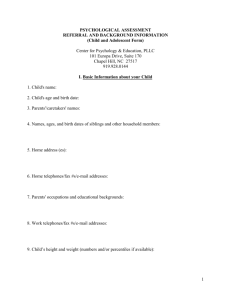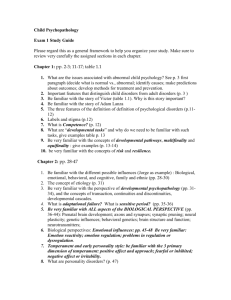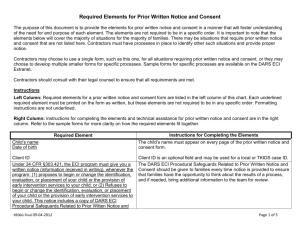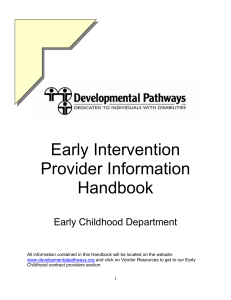Slide Notes: Needs Assessment
advertisement
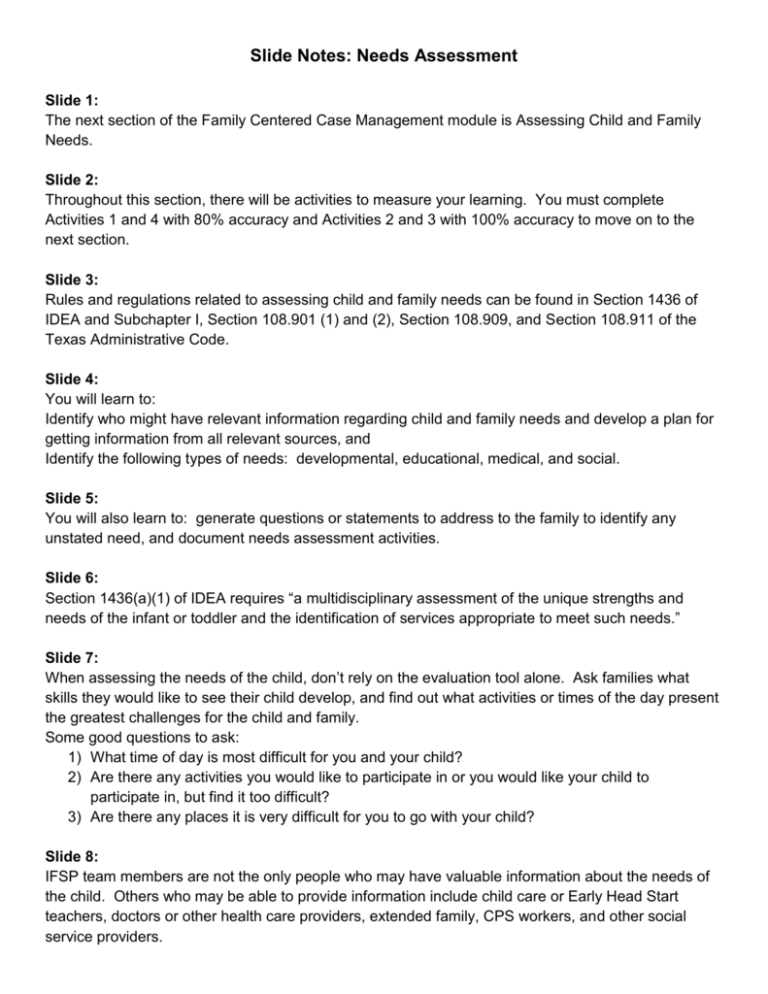
Slide Notes: Needs Assessment Slide 1: The next section of the Family Centered Case Management module is Assessing Child and Family Needs. Slide 2: Throughout this section, there will be activities to measure your learning. You must complete Activities 1 and 4 with 80% accuracy and Activities 2 and 3 with 100% accuracy to move on to the next section. Slide 3: Rules and regulations related to assessing child and family needs can be found in Section 1436 of IDEA and Subchapter I, Section 108.901 (1) and (2), Section 108.909, and Section 108.911 of the Texas Administrative Code. Slide 4: You will learn to: Identify who might have relevant information regarding child and family needs and develop a plan for getting information from all relevant sources, and Identify the following types of needs: developmental, educational, medical, and social. Slide 5: You will also learn to: generate questions or statements to address to the family to identify any unstated need, and document needs assessment activities. Slide 6: Section 1436(a)(1) of IDEA requires “a multidisciplinary assessment of the unique strengths and needs of the infant or toddler and the identification of services appropriate to meet such needs.” Slide 7: When assessing the needs of the child, don’t rely on the evaluation tool alone. Ask families what skills they would like to see their child develop, and find out what activities or times of the day present the greatest challenges for the child and family. Some good questions to ask: 1) What time of day is most difficult for you and your child? 2) Are there any activities you would like to participate in or you would like your child to participate in, but find it too difficult? 3) Are there any places it is very difficult for you to go with your child? Slide 8: IFSP team members are not the only people who may have valuable information about the needs of the child. Others who may be able to provide information include child care or Early Head Start teachers, doctors or other health care providers, extended family, CPS workers, and other social service providers. These examples are not exhaustive. Be discreet and thoughtful when contacting others about child and family needs. Be sensitive in asking questions and do not contact collateral sources about very personal information unless you are sure the parent is comfortable with it. Remember that you will always need written parental consent to contact others about the child and family. Slide 9: Now, practice what you have learned. Complete Needs Assessment Activity 1 Slide 10: Needs assessment is a team process. All team members should mention any needs they see, even if the parents do not identify those needs. It is the family’s right to determine which needs they would like to address. They may choose to wait to address some needs, or to not address them at all. Slide 11: You should be looking at four types of needs for all the children on your caseload. Developmental needs include skills the child needs to learn to catch up to their peers. Examples include: Learning to pull to stand or beginning to chew solid foods. A second needs area to assess is education. Educational needs do not only apply to kids approaching transition. Younger children may also have an identified need for educational services, such as Early Head Start. Medical needs include finding appropriate health care providers, medications, and specialized equipment. Social needs refer to assistance from community providers, such as WIC, food pantries, or housing agencies. The family may have other needs that do not fit in these categories. These needs should also be documented. Slide 12: Section 1436(a)(2) of IDEA requires “a family-directed assessment of the resources, priorities, and concerns of the family and the identification of the supports and services necessary to enhance the family's capacity to meet the developmental needs of the infant or toddler.” Slide 13: “…Supports and services necessary to enhance the family's capacity to meet the developmental needs of the infant or toddler” is a very broad statement. Remember Maslow’s Hierarchy of Needs. If a family is having a hard time meeting more basic needs, they cannot focus on meeting their child’s developmental needs. Physical needs, such as hunger, and safety needs, such as adequate housing, must be addressed before families can focus on the developmental and social-emotional needs of their child. Slide 14: The supports ECI programs provide generally fall into three categories: material, emotional, and informational. Material supports are what we tend to focus on. They include ECI services, financial assistance, and help getting items like medications, groceries, and diapers. But for many families, emotional and informational supports are just as important. Nearly all families coping with a child with special needs, even those that may seem mild, need emotional support. Emotional supports include parent support groups, counseling, and advocacy support service. One very important type of emotional support ECI staff can provide is being able to listen to and empathize with families. Informational supports might include articles, books or websites about a particular issue, but they also include the information ECI staff provide to families about child development, and the unique strengths and needs of their child. Slide 15: Before you start your comprehensive needs assessment, you will need to get written parent consent. However, you will already have some information about the child and family, such as the information you received in the referral and in any previous conversations with the family. Many parents provide a great deal of information about their child and family before the needs assessment formally begins. Be sure to bring this information forward, as well as information other team members may have, so that families do not have to repeat the same conversations over and over. Build on what you have already learned. Slide 16: Listening is the most important skill in completing a needs assessment. Actively listening lets the family know you really want to learn more about them and gives you an opportunity to identify needs a family may not share directly. Families may identify some needs easily—for example, “I need help getting Josie to the doctor.” But there may be some needs they do not identify directly. For example, Josie, her mother, and sister live in a two bedroom apartment with her aunt and three cousins. Even though Josie’s mother did not identify housing as a need, you might want to ask if she is happy with her living situation. But do not assume she wants to change it without asking. Active listening means that you don’t assume what a family needs based solely on their living situation or economic status. Always ask families what they need and how they would like you to help. Slide 17: Now, practice what you have learned. Complete Needs Assessment Activity 2 Slide 18: Many new Service Coordinators worry about offending families by asking personal questions. However, most families come to ECI because they are concerned and want help. Most families are relieved to have someone to talk to about their fears and worries. All families, even those whose children are severely impacted by disability or illness, have hopes and dreams for their children and may not have a safe outlet to talk about those. Even if the hopes are unrealistic, they can serve as a guide in helping families meet the needs of their children. Some important questions to ask include: What concerns you the most about your child? What are your fears for your child and family? What are your hopes and dreams for your child? Slide 19: Now, practice what you have learned. Complete Needs Assessment Activity 3 Slide 20: Needs assessment does not end when the IFSP is written. It is an ongoing process, and new needs should be identified as children and families change. As a child meets their original developmental goals, new developmental needs might be identified. In rare cases, children regress, and new needs must be identified. As families approach transition or cope with other changes, related needs must be identified and addressed. Maintaining regular contact with families you serve provides the opportunity to identify new needs. Slide 21: Once needs have been identified, you need to document them. Needs identified during preenrollment should be documented in the IFSP. Needs identified following IFSP development may be documented in the IFSP or in progress notes. Regardless of where the needs are documented, the documentation must include: the child’s name, date of contact, whether the contact was face-to-face or via the phone, a description of the needs, plans and timelines for meeting the needs, and the start time and length of service. If needs are documented in a progress note, there must be a means for ensuring follow-up. For example, regular review of case management notes from previous contacts may remind you of identified needs that have not been met. Identifying needs is pointless if there is no follow-up. Maintaining regular contact with families gives you a chance to review previously identified needs to see which have been met and which might require more follow-up. Slide 22: Now, practice what you have learned. Complete Needs Assessment Activity 4 Slide 23: Congratulation on completing Assessing Child and Family Needs. In this section, you received information on: identifying who might have relevant information regarding child and family needs and developing a plan for getting information from all relevant sources, and identifying the following types of needs: developmental, educational, medical, and social. Slide 24: You also received information on: generating questions or statements to address to the family to identify any unstated needs, and documenting needs assessment activities. You may now move on to the next section, Monitoring and Developing the Case Management Plan.





